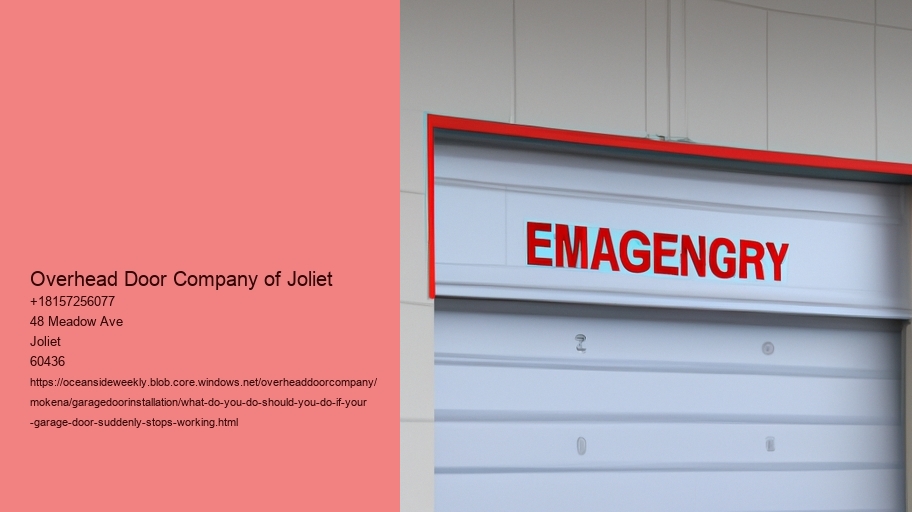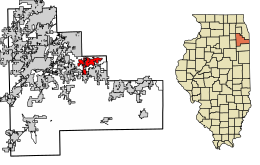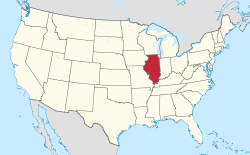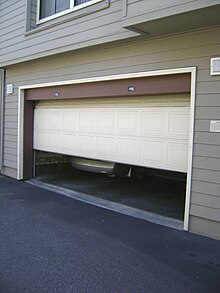What kind of garage door Opener and Door Do You Have? What is the one thing You Should Do When Your Garage Door Suddenly Stops Working? .
It is vital to identify the garage door and opener that you are using before you begin troubleshooting.
Roll-up garage doors commonly used in commercial settings, are made from slats that are then rolled up into a coil.
The tilt-up door, on contrary, is a solid, single piece that opens by tilting outward up.Belt-drive garage door openers have a lower noise but they use an elastic band instead of a chain. They're a fantastic option for garages with attached garages. Screw-drive garage door openers employ a rod with a threaded steel for moving the garage door. This is the best option for noise and cost.
Once you have identified your garage door opener type then the next step is to perform simple checks for common issues.Ensure that the power source is connected to the opener by checking the plug and breaker.Inspect the manual release cord to make sure that it's not pulled, which will disconnect the door from the opener.Examine the tracks of the door and rollers to see if they have obstructions or damages and remove any obstructions.
Lubricate moving parts when needed because a lack of lubrication can lead to jamming or sticking.Resetting your opener is a solution to any electronic issues. Refer to the instruction manual of the model you have to know the specific steps. Some openers can be reset with a push of a button while others require to be disconnected from the unit and after that, it must be re-plugged.
In a few cases the problem may be more complicated such as a broken spring or a motor that is worn out which requires expert assistance.Springs are in a high tension, and they can be dangerous to repair without the appropriate tools and skills.
When your garage door suddenly stops working then you need to speak with a professional.
Examine for obstructions and debris
It's frustrating and confusing when the garage door stop working in a flash, especially if are using it daily.
One of the primary and most efficient steps you can take when faced in this scenario is to search for obstructions or debris.This simple, yet powerful action could be the answer to identifying the problem and restoring the functionality of your garage door.Garage doors run by a set of rollers, tracks, as well as other parts that need to be clear of any obstacles to work smoothly.Over time, dirt, leaves, tiny rocks, or any other debris could accumulate along the tracks, or get trapped in the rollers.Even a small obstruction can cause the door to stop opening or closing properly.Therefore it is imperative to conduct a thorough examination of these parts should be the first step.
Begin by taking a close look at the tracks on both sides of the door.Look for any obvious obstructions or the accumulation of debris.If you see anything strange like a twig or a stone stuck in the track, make sure you remove it.
The issue might not always be apparent. To check whether the issue is present, move your fingers across the track. Also, ensure that the tracks are aligned. Misalignment can create a jam in the door.Check the hinges and rollers. The parts should be free to move without any resistance. If they're stuck or sticky, it could be caused by rust or grime. Lubricating and cleaning them can typically solve the issue.
It's also crucial to examine the space around the door itself.Sometimes things stored inside the garage may accidentally slide or shift, obstructing the route of the door.Ensure that the space is cleared and that there's nothing that is hindering the door's motion.
If, after clearing all obvious obstructions, your door continues to refuse to open check the sensors.
Modern garage doors are fitted with safety sensors that prevent doors from closing when something happens to be detected within its path.Make sure that these sensors are maintained and properly aligned, as dust or improper alignment can cause them to malfunction.By keeping your walkway clean and avoiding obstructions, you can stay clear of having to call a professional solve a problem that is often easy to fix.
Examine the wall switch and remote control
It's important to check the wall switch as well as the remote control.
Examining these components can help you save time and prevent costly errors.First, consider the remote control.This handheld device is your primary tool for operating the garage door without direct physical interaction.Over time, remote controls can experience issues such as drained batteries, signal interference, or even internal damage.Start by replacing the batteries with new ones.It might seem simple, but dead batteries are a common reason for a garage door not responding.If the problem persists after replacing the batteries, try reprogramming the remote according to the manufacturer's instructions.Additionally, ensure that the remote is within the recommended range and that there are no obstructions blocking the signal.
Next, you should pay attention towards the wall switch. It is a crucial component of the garage door's design.
If you're comfortable and comfortable, you can open the switch to check for damaged or disconnected wires.In some instances, the the wall switch may be functioning properly however the door is unresponsive.This could indicate a problem with the garage door opener unit or other components such as the sensors or the door tracks.However it is best to start by utilizing the wall switch and remote control is the logical first step.
It helps you rule out these common issues prior to moving on to more complicated troubleshooting strategies.This initial inspection can make it easier for you to get your work done and provide peace of mind that you've taken the proper steps to diagnose your problem.
Verify the door's balance by hand
It can be frustrating and frustrating when your garage door stops functioning. Garage doors are an essential component of your house, as it gives you security, protects from the elements, and ease of access to your car and storage space.
The first step you must take when faced with an issue with your garage door is to test manually the door balance.This simple yet effective procedure can assist in identifying potential issues and prevent further damage to the door or its components.The equilibrium of a garage door is vital to the proper functioning.A properly balanced door makes sure that the opener does not have to perform more work than it needs to, thus reducing the possibility of wear and tear on the motor as well as other parts.An unbalanced door, in contrast, can lead to more severe issues over time such as misalignment, broken springs, or an entire system failure.Therefore, testing the door balance is a crucial test that will assist in determining whether the issue is in the door or the opener mechanism.
To check the door's balance, begin by disconnection of the garage door opener.
The majority of garage doors come with an release mechanism, usually an orange cord or handle that lets you disconnect the door from the motor.Once the door has been disconnected from the motor, gently lift it to about waist height, and then release it.A well-balanced door will remain stationary or move very slowly.If the door drops quickly or shoots upwards this indicates an imbalance.If you observe that the door isn't balanced it is vital to take care of the issue promptly.Door balance problems are typically caused by the tension of springs. They could be risky to adjust by yourself due to the pressure they're under.It is advised to seek assistance from a professional for adjusting the springs and make sure that the door is well-balanced correctly.Doing this not only fixes the immediate problem but also improves the durability and longevity of your garage door's mechanism.
In the end, testing manually the door balance is an important first step to take when your garage door suddenly stops working.
What do you do should you do if your garage door suddenly stops working? - secondary school
- Hickory Hills
- price
- secondary school
Examine the Tracks and Rollers
If you're confronted with a garage door that is suddenly refusing to open, your initial reaction is likely to be worry or consider the most complex technical issues.However, often the solution lies in a simple inspection of the tracks and rollers.This essential check will reduce time and costly repairs, making it the one priority in the event that your garage door ceases functioning.
The tracks and the rollers of your garage's operation system are essential. The tracks are the metal rails that help guide the door when it opens, and the rollers travel through the tracks.
These components can wear out, become dirty or misaligned over time. This can lead to operational problems.Begin by examining the track for any obstructions. The accumulation of dirt, dust and even tiny particles can build up, making rollers struggle to travel across the track. Cleaning the tracks with a damp cloth can solve the issue.
The next step is to check the alignment of the tracks. Tracks should be straight and parallel. If they appear bent or are out of alignment, then the door could become jammed. You can press the wrongly aligned section back to its proper position using mallets made of rubber. If there is a lot of damage, it's recommended to consult professionals who can re-align the tracks correctly.
Rollers can become worn out with time. This is especially the case if they're made of plastic.
Metal rollers that have bearings last longer and provide an easier operation.Additionally, lubrication also plays a crucial role in ensuring the seamless movement of tracks and rollers.Applying a silicone-based lubricant can reduce friction and prevent wear.Make sure that you lubricate the moving parts, such as springs and hinges to ensure that your garage door is operating effectively.
If you ensure that these parts are well-lubricated and aligned It is possible to get the garage door back to its full functionality.
The time taken to inspect and maintain the parts will help avoid any future issues, extending the life span of your garage door system.Be on the lookout for visible damage or wear
If garage doors suddenly stop working, it can be very frustrating and aggravating especially when you're in the process of leaving or trying to make sure your home is safe for evening.While there could be various causes for the problem but one of the most effective and quick options is to search for signs of damage or wear.This first inspection will usually identify the source of the problem, allowing to find a swift and efficient solution.
Garage doors are a complex system that is made up of a variety of parts, like springs cables, rollers, and tracks, each of which plays vital roles in the smooth operation.Over time, these parts can experience wear and tear from regular usage and exposure to environmental elements.
When you conduct a thorough examination, you will be able to identify any obvious signs of damage that may be creating problems for the door. Begin by checking the springs, which are vital for the lifting and lowering of the door.Look for any signs of rust, breakage, or misalignment.A broken or worn-out spring could make the door unusable and it is crucial to take care of this issue promptly.Next you should look at the cables and check for damaged or frayed wires that might hinder the door's movement.Similarly, inspect the tracks and rollers for any signs of damage, debris, or obstructions that may hinder the door's movement.
What do you do should you do if your garage door suddenly stops working? - secondary school
- Democratic Party
- glass
- COVID-19 pandemic
The door is another area that needs the attention of a professional. Be aware of visible dents, warping, or bends.
Furthermore, ensure that the door's sensors are clean and aligned, because misalignment or dirt could interfere with their functions and result in the door not functioning.An inspection of the visuals is helpful however it's essential to be aware that not all problems are evident. If you don't see any obvious indications of wear or damage you may need to consult with a specialist to pinpoint the problem.
In conclusion, when you are confronted by a malfunctioning garage door, examining it for signs of wear or damage is the first step.This approach not only helps in identifying the issue swiftly but also helps you make the appropriate action to restore the door to working properly.
You can prolong the life of your garage door simply by being proactive.Verify the Springs and Cables
It can be frustrating when your garage door stops functioning. You must check the springs and the cables. These are crucial to the operation of your garage, and are the main culprits for malfunctioning garage doors.
Springs play a vital role in the operation of the garage door, counterbalancing its weight.When the door is in motion the springs carry the bulk of the load allowing the door to shut and open smoothly.There are generally two kinds of springs: the torsion and extension springs.Torsion springs are mounted over the garage door and twist to store energy, while extension springs are situated to both sides of the door and can stretch to allow the required force.
The springs could be worn out with time break, or lose tension, causing operational issues.The cables could also be damaged due to wear and tear. They can fray or snap when pressure is applied.
In the process of assessing springs and cables, start by visually checking them.Look for signs of wear, rust, or fraying.If you find a damaged cable or spring It is important to refrain from opening the door until the problem is solved, since pushing it may cause further damage or even lead to an accident.If springs look in good shape but the door is not functioning, it could be that they've lost tension and require adjustment.
It's essential to consider safety when dealing with garage door components.
The springs and cables are stretched and may result in serious injuries. If you don't have experience in garage door repairs, it's best to call a professional.What do you do should you do if your garage door suddenly stops working? - Hickory Hills
- higher education
- pride
- golf course
In conclusion, when your garage door suddenly stops working, assessing the springs and cables is a key step in diagnosing the problem.Understanding their role and potential issues can help you determine whether a simple adjustment is needed or if professional intervention is required.Taking prompt action not only restores functionality but also ensures the safety and longevity of your garage door system.
Think about calling a professional technician
If your garage door suddenly stops working and it is not working, it could disrupt your routine and could even be an security threat to your home.
It may be tempting to pick up an instrument box to attempt a fix by yourself however it is better to contact an expert. This choice is not just about your safety, but also offer a long-lasting, more efficient solution.Garage doors are complex systems composed of various components such as springs, cables, tracks, and electronic parts.Each of these elements plays a crucial role in the door's operation, and a malfunction in any part can cause the entire system to fail.Without proper knowledge and experience, attempting to fix these issues can be dangerous.For instance, garage door springs are under high tension and can cause severe injury if handled improperly.Professional technicians are trained to deal with these risks safely, using the right tools and techniques to handle repairs.
A skilled technician also brings a level of competence and knowledge to the table that a layperson does not possess.
They can quickly diagnose the issue and identify whether it's a minor problem, like a misaligned track, or something more serious, like a broken spring.This expertise not only saves you time but also prevents the potential for further damage that can occur with incorrect handling.Professionals also have access to high-quality parts and can ensure that replacements match the specifications of your existing garage door system, leading to better functionality and longevity.Additionally, hiring a professional can save you money over the long run.While an DIY option may appear cheaper initially, the likelihood of mistakes is high. This could lead to larger and more costly repairs in the future.A professional technician will complete the task exactly the first time, minimizing the risk of repeating issues.
Many technicians offer warranties on their work. This gives you assurance that when something goes wrong, the issue is insured.A professional could save you a lot of time and hassle.Trying to understand the complexities of garage door mechanics, buy the right tools, and carry out an repair can take hours or days.In the opposite, a technician will often be able to resolve the issue in a short time, allowing you to return to your normal routine without unnecessary delays.
In conclusion, while the desire to fix your garage door yourself might be strong, calling an expert technician is the safest option, the most efficient, and ultimately the most sensible option.Their skills, experience in locating quality parts, and the ability to carry out quick and precise repair work will make sure that your garage door is back and running at a high level, protecting both your home as well as your family.


















